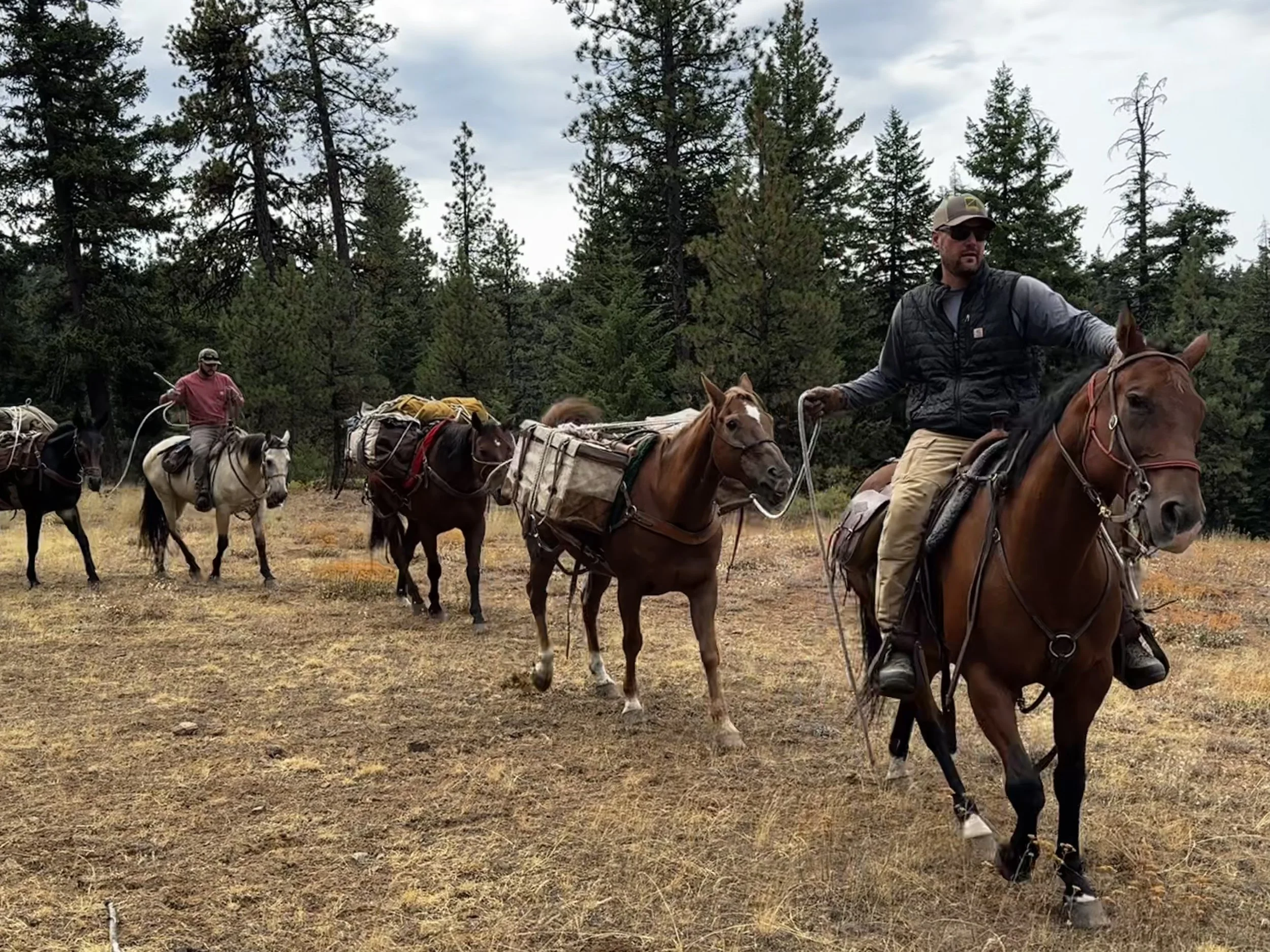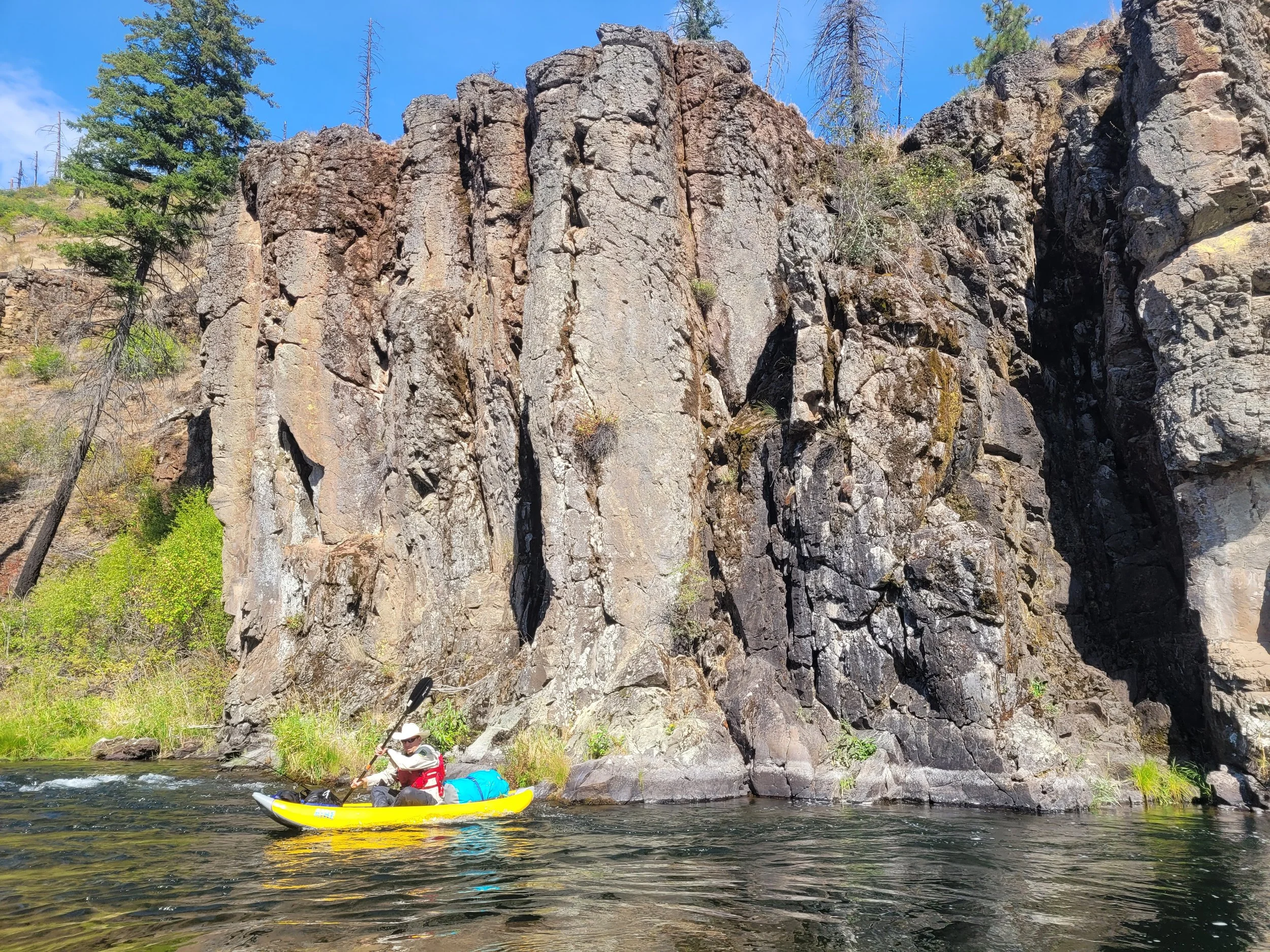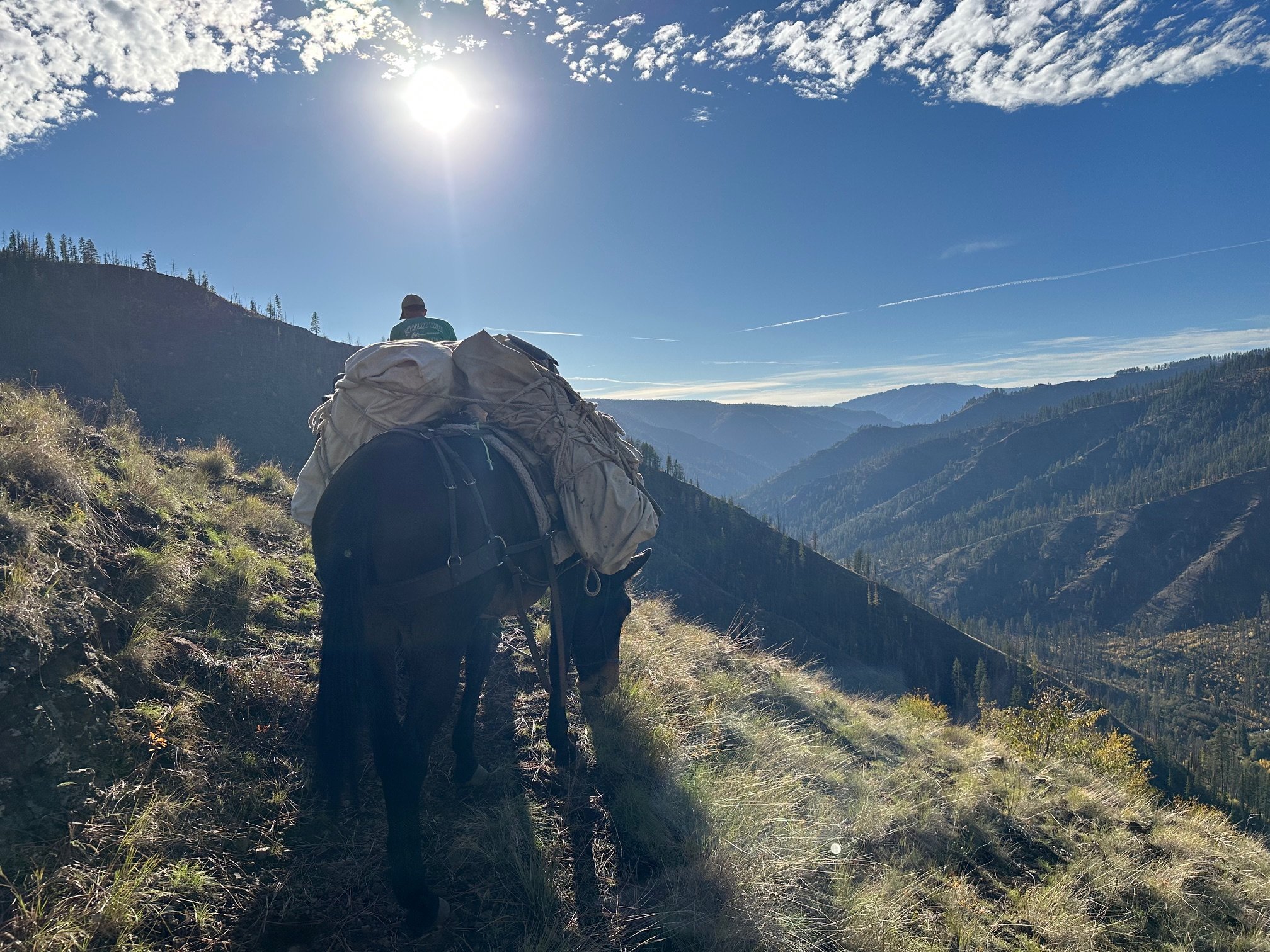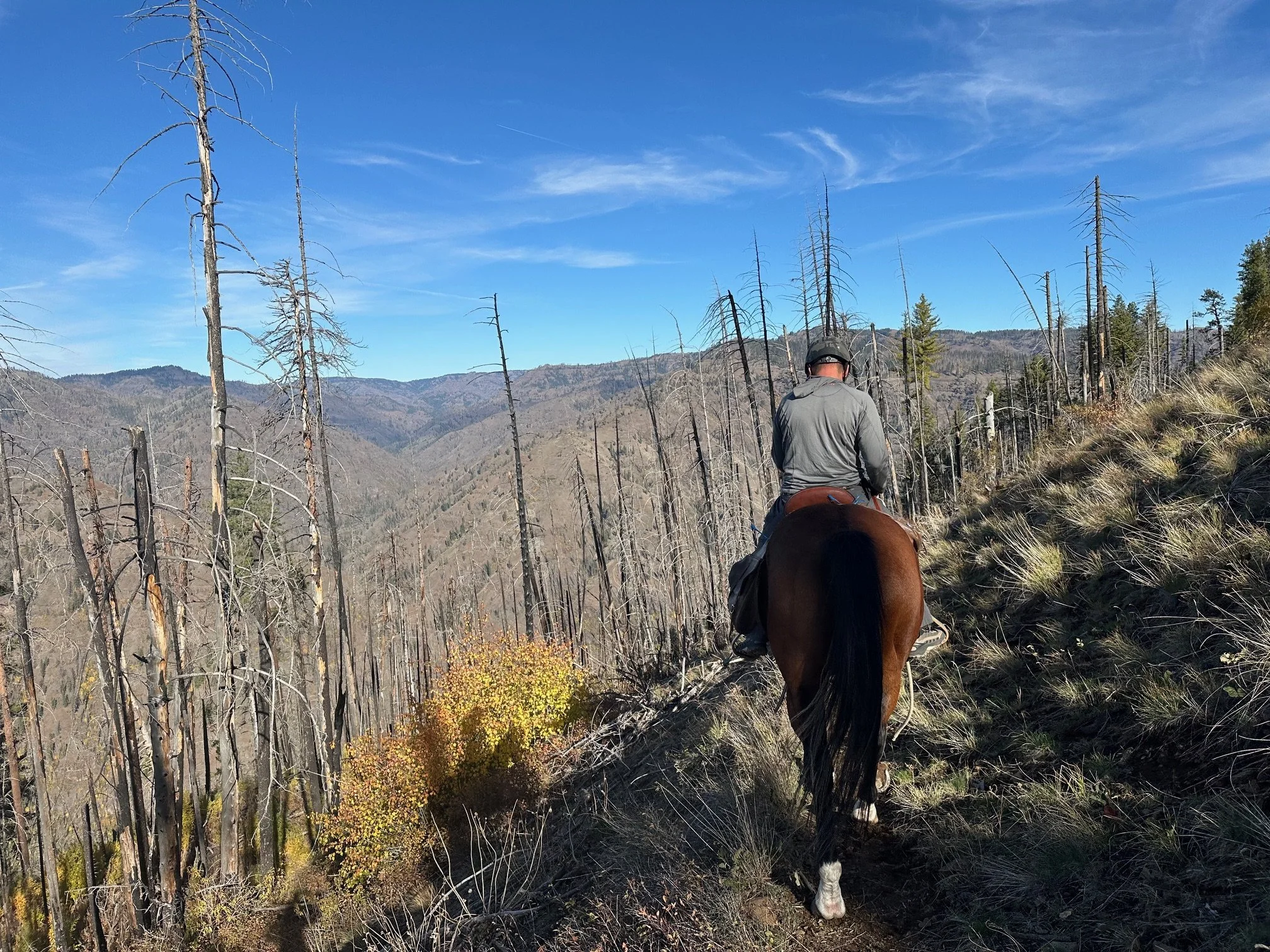A Thank You Letter to our 4-legged Wenaha Crew Members
Dispatches from MS student Emily Treadway working in the Wenaha River basin in eastern Oregon. Learn more about her project here!
This summer the Wenaha River Project wrapped up its wild ride of two field seasons. Emily Treadway led crews via kayak and horseback through the Wenaha Wilderness to complete spawning grounds surveys for a natural population of spring Chinook Salmon. The Wenaha River is a wild and scenic river with no road access, making all sampling efforts require complex logistics and sweat equity to accomplish. These surveys are truly “wild” and would not have been possible without the contributions of the Oregon Department of Fish & Wildlife horse packing team.
The Wenaha River canyon from Hoodoo Trail. Credit: Emily Treadway
Phillip Perrine and Corey Crossely packing in survey equipment into the Wenaha River canyon with Lil Joe, Scooter, Pistol, Scout and Marley. Credit: Emily Treadway
The summers were kicked off by installing four remote passive integrated transponder (PIT) antennas throughout the Wenaha River spawning grounds to detect tagged fish movement patterns. Each site requires a 40–60 ft long antenna, a black weatherproof computer box, two 35 lb lithium batteries and a 4x6 ft solar panel. Thankfully, the journey was all downhill into the canyon! While human power was used to get it all down there, getting it all back out was a job for our 4-legged coworkers. After these antennas collected data from June through October for two seasons, the horses and mules packed out everything up the 2500 ft canyon. Thanks to the packing team, 3,420 detections across 661 individuals from spring Chinook Salmon, Bull Trout, Mountain Whitefish, Rainbow Trout, and Steelhead were collected.
Gerrit Buch, Polly Gibson, Joseph Feldhaus, and Justin Fisk packing in the solar panel for one PIT antenna installation. Credit: Emily Treadway
Mike Lance, Scooter, Marley and Gigi (unpictured) packing out the mainstem PIT antenna equipment. Credit: Emily Treadway
The core sampling of this project required the sampling crew to complete weekly floats from the headwaters of the Wenaha River to the mouth in Troy, OR. This is a 22 mi floating journey completed via inflatable kayaks. Cue the packing team, who every week would carry in the kayaks, float gear, camping gear and food for the week. Surveyors could then arrive at camp with all of their gear waiting for them after hiking and surveying for 12 miles through brush and stream. Surveyors spent week after week living in the wilderness, kayaking the spawning grounds collecting bio data from spawned carcasses, marking redds, and recording live adult Chinook Salmon. The heavy lifting of the horse packing team allowed crews to identify and quantify the presence of stray hatchery origin spring Chinook Salmon that are spawning with natural origin Wenaha River fish. [Read more here!]
A pile of kayaking gear required for surveying. (Unpictured, the other half of the gear) Credit: Emily Treadway
Joseph Feldhaus paddles down the Wenaha River looking for Chinook Salmon. Credit: Emily Treadway
This project required many long, hard nights and days spent on the Wenaha River spawning grounds, which was no small feat. So, a final thanks to all the people that poured their literal blood, sweat, and tears into this field work, ODFW East Region Fish Research's’ Lower Snake River Compensation Plan team, and Life Cycle Monitoring Team. And finally, a special MASSIVE thank you to our unsung heroes, the 2-legged Phillip Perrine , Corey Crossley, Brian Ratliff, Dusty Deehan, and Mike Lance as well as the muscle of the operation, Scooter, Lil Joe, Pistol, Scout, Marley, and Gigi.
Snack break on the trail during the PIT antenna gear pack out. Credit: Emily Treadway
Packing down to remove the Butte Creek PIT antenna. Credit: Emily Treadway
Another VIEW Fellowship Summer Completed!
Over the summer, undergraduate student Cristian Burke was selected for the Vanguarding an Inclusive Ecological Workforce (VIEW) Fellowship, hosted by the Fisheries, Wildlife, and Conservation Sciences Department. The VIEW Fellowship aims to provide a mentored research experience to members of underrepresented communities or backgrounds, pairing participants with a faculty member/lab for the summer. VIEW placed him in the Fish Behaviorscapes Lab (FBL), where he worked under the supervision of FRA Ashley Sanders at the Aquatic Animal Health Lab (AAHL) to study hatchery fish ecology and work as a facilities technician. He did a stellar job learning a new analysis software and we are looking forward to working with him through the school term - thanks Cristian!
Cristian Burke - VIEW Fellow in Summer 2025
We asked Cristian to tell us a little about what he did over the summer:
In this fellowship, I worked on the Olfactory Imprinting Project (OIP), a project dedicated to better understanding how salmon imprint and home. Part of the project is focused on how olfactory imprinting, or a fish’s ability to remember smells in the water, can be used by fish managers to draw hatchery fish back to where they were released. A few years back, the OIP team ran a series of behavioral Y-maze experiments with juvenile Fall Chinook Salmon to find new imprinting odor candidates, or odors that neither inherently attract or repel fish, but that they may be able to imprint on and use to home.
In these trials, a juvenile fish is placed at the base of a maze with water running from 2 branches, 1 with an odor dripped into it and another without, just well water. The fish acclimates for 5 minutes at the base of the maze until a gate is pulled and it is allowed to travel anywhere in the maze during a 10 min trial period. Once the trial is finished, fish are removed, the odor arms are switched, and another trial with a new fish begins. These trials are conducted in the dark and video footage is captured from above looking down on the mazes that are illuminated with infrared light from below.
My contribution to the OIP involved processing and analyzing the team’s footage of those trials (15 odors x 96 trials) with a video processing software called Ethovision XT. I was tasked with specifying the areas of interest, running the tracking software, then correcting points in the tracking where the software made mistakes. The data are then downloaded, saved, and analyzed with a code we developed in R Studio.
Snapshot of what Ethovision video processing looks like
Working with the video footage can be a long, frustrating process if the stars align in the worst ways, but it’s rewarding when patterns and solutions that improve efficiency begin to manifest. So far, the footage from 3 out of the 15 odors tested have been fully processed. Despite the conclusion of the 2025 VIEW Fellowship, I will continue to work with the FBL to finish the rest of the video processing and explore the full capacities of the processing software to answer other questions. Additionally, I will begin working on an individual project to present at an upcoming conference, stay tuned!
-Cristian Burke
FBL goes to ORAFS!
We just wrapped up an awesome week at the Oregon American Fisheries Society in Bend, OR. We collectively presented 4 student talks, 1 OHRC staff talk, and 2 undergraduate posters this year. Plus, our own Emily Treadway was awarded the Masters Scholarship and Kasey Ingram won the Best Student Poster Award, which includes a free trip to regional AFS in Colorado later this year! It was great to see such a strong representation from our lab and connect our research with practitioners and other researcher groups working on similar topics and motivated by the same mission.
One thing I took away from this year’s meeting is how important it is to use this time to connect to people who are experts in new techniques and technologies. From the sessions I attended, I learned about new eDNA techniques that could potentially change the way Kasey and I process our fish pathogen samples, and in the same session, I learned about the JSOES marine survey that produces amazing data on juvenile fish survival in the ocean, which has historically been a black box in my mind. The availability of those data could be an interesting link to the Coos River Hatchbox Study we are working on with the Coquille Tribe to monitor survival or phenotype at another time stamp. We (at least I) always assume that all knowledge we need is available on the internet these days, but I realized that connecting to other people is the best way to explore what is out there while saving your time and brain space. Advanced techniques seem so overwhelming from a publication, while a 5 min explanation from the author can provide all the clarity necessary to understand how it could be useful for something you’re working on. From this point forward I am going to challenge myself to expand my social network at meetings to broaden my understanding of new techniques, which will ultimately change the way I approach new research questions.
-Ashley Sanders, FRA




















